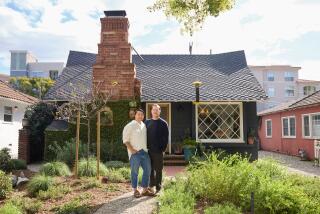Tying the Knot
It all began with a trip to the Cotswolds, where Los Angeles gardening enthusiast Yvonne Caan toured the estate of English landscape great Rosemary Verey. There, amid soft lawns and flower borders crafted by the legendary designer, was a clipped collage that caught Caan’s eye. Woven of dwarf boxwood and phillyrea hedges, flanked with variegated topiary hollies, it was an old-fashioned knot garden based on a 17th century embroidery pattern.
Such intricate compositions were common in Elizabethan England. Forged of intertwining ropes of evergreens and herbs, they were often framed by an additional, enclosing hedge, creating what Caan calls “a garden surprise.”
Intrigued by the possibilities of Verey’s knot, Caan returned to the English-style Brentwood house that she had just bought with her husband, Michael. Their half-acre was very much a work in progress, and Caan found a vacant spot beside her rose beds where a knot design would fit nicely. “I don’t like predictable gardens,” she explains. “I thought to myself, how many places do you need for sitting? We had those. What we lacked was the element of the unexpected.”
Diana Green, Caan’s Santa Monica-based landscape designer, agreed, and went to work transforming an unused lawn into a delicate piece of petit point. For the garden’s form, she created a pattern inspired by knot gardens that she herself had seen in England. For its interlocking skeins, she opted for hardy shrubs with contrasting colors and textures that would make the lines read clearly, especially when glimpsed from an upper terrace. Beginning with a variegated euonymus, she added fragrant rosemary and boxwood, both appropriate, she says, for the climate and conditions. To ensure a quick fill-in of the hedges, she installed one-gallon plants closely spaced, and a year later, in the spring of 1997, the knot pattern was complete.
An earthen path edges the garden, and gravel blankets the ground between the hedges, which gather in a square around a simple concrete fountain. Framing the knot are perennial borders conceived, says Green, to soften the hard strokes of the formal design, as well as to thrive in the heavy shade of an existing sycamore tree. Nandina shrubs provide color in the fall, and callas, daylilies and agapanthus bloom seasonally, from spring throughout the summer. Amid their tall profusion is yet another surprise: a gazing globe that reflects the twists and turns of the nearby knot.
As to maintenance, Caan says, the hedges need clipping by hand every four to five months, as electric shears can leave foliage ragged and brown. “People think that’s too much work,” she concedes. “Of course, it depends on your standards of perfection. But, yes, you have to keep it up. After all, gardens grow, right? That’s what they do.”
(BEGIN TEXT OF INFOBOX / INFOGRAPHIC)
The Queen of Green
British gardeners consider 80-year-old Rosemary Verey a national treasure, and rightly so. In addition to designing lush landscapes for the likes of Elton John and Prince Charles, she has written the book--actually, many books--on English garden style, and has traveled the world lecturing on gardening. Earlier this year she was awarded the Victoria Medal of Honour, her country’s top horticultural prize. In her own garden around a 17th century stone house in Gloucestershire, England, she has spent 40 years crafting a series of simple yet dramatic scenes, from the twining knot pattern to a potager that features hops scrambling up arbors and goblet-shaped apple trees. She is famous for sharing her mix of formal gardens and flower borders with the public, and even coming out to chat during visiting hours.






